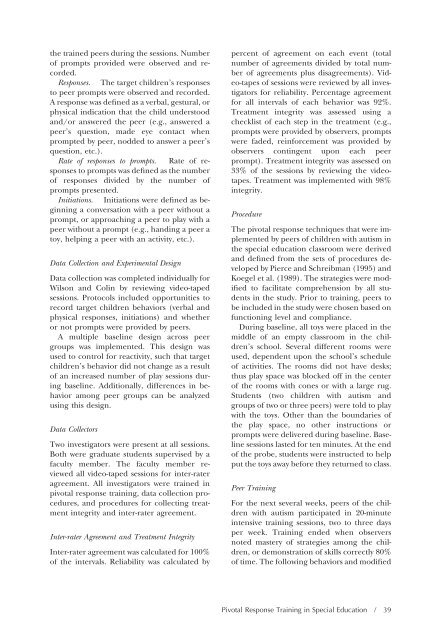Download the Journal (PDF) - Division on Autism and ...
Download the Journal (PDF) - Division on Autism and ...
Download the Journal (PDF) - Division on Autism and ...
Create successful ePaper yourself
Turn your PDF publications into a flip-book with our unique Google optimized e-Paper software.
<str<strong>on</strong>g>the</str<strong>on</strong>g> trained peers during <str<strong>on</strong>g>the</str<strong>on</strong>g> sessi<strong>on</strong>s. Number<br />
of prompts provided were observed <strong>and</strong> recorded.<br />
Resp<strong>on</strong>ses. The target children’s resp<strong>on</strong>ses<br />
to peer prompts were observed <strong>and</strong> recorded.<br />
A resp<strong>on</strong>se was defined as a verbal, gestural, or<br />
physical indicati<strong>on</strong> that <str<strong>on</strong>g>the</str<strong>on</strong>g> child understood<br />
<strong>and</strong>/or answered <str<strong>on</strong>g>the</str<strong>on</strong>g> peer (e.g., answered a<br />
peer’s questi<strong>on</strong>, made eye c<strong>on</strong>tact when<br />
prompted by peer, nodded to answer a peer’s<br />
questi<strong>on</strong>, etc.).<br />
Rate of resp<strong>on</strong>ses to prompts. Rate of resp<strong>on</strong>ses<br />
to prompts was defined as <str<strong>on</strong>g>the</str<strong>on</strong>g> number<br />
of resp<strong>on</strong>ses divided by <str<strong>on</strong>g>the</str<strong>on</strong>g> number of<br />
prompts presented.<br />
Initiati<strong>on</strong>s. Initiati<strong>on</strong>s were defined as beginning<br />
a c<strong>on</strong>versati<strong>on</strong> with a peer without a<br />
prompt, or approaching a peer to play with a<br />
peer without a prompt (e.g., h<strong>and</strong>ing a peer a<br />
toy, helping a peer with an activity, etc.).<br />
Data Collecti<strong>on</strong> <strong>and</strong> Experimental Design<br />
Data collecti<strong>on</strong> was completed individually for<br />
Wils<strong>on</strong> <strong>and</strong> Colin by reviewing video-taped<br />
sessi<strong>on</strong>s. Protocols included opportunities to<br />
record target children behaviors (verbal <strong>and</strong><br />
physical resp<strong>on</strong>ses, initiati<strong>on</strong>s) <strong>and</strong> whe<str<strong>on</strong>g>the</str<strong>on</strong>g>r<br />
or not prompts were provided by peers.<br />
A multiple baseline design across peer<br />
groups was implemented. This design was<br />
used to c<strong>on</strong>trol for reactivity, such that target<br />
children’s behavior did not change as a result<br />
of an increased number of play sessi<strong>on</strong>s during<br />
baseline. Additi<strong>on</strong>ally, differences in behavior<br />
am<strong>on</strong>g peer groups can be analyzed<br />
using this design.<br />
Data Collectors<br />
Two investigators were present at all sessi<strong>on</strong>s.<br />
Both were graduate students supervised by a<br />
faculty member. The faculty member reviewed<br />
all video-taped sessi<strong>on</strong>s for inter-rater<br />
agreement. All investigators were trained in<br />
pivotal resp<strong>on</strong>se training, data collecti<strong>on</strong> procedures,<br />
<strong>and</strong> procedures for collecting treatment<br />
integrity <strong>and</strong> inter-rater agreement.<br />
Inter-rater Agreement <strong>and</strong> Treatment Integrity<br />
Inter-rater agreement was calculated for 100%<br />
of <str<strong>on</strong>g>the</str<strong>on</strong>g> intervals. Reliability was calculated by<br />
percent of agreement <strong>on</strong> each event (total<br />
number of agreements divided by total number<br />
of agreements plus disagreements). Video-tapes<br />
of sessi<strong>on</strong>s were reviewed by all investigators<br />
for reliability. Percentage agreement<br />
for all intervals of each behavior was 92%.<br />
Treatment integrity was assessed using a<br />
checklist of each step in <str<strong>on</strong>g>the</str<strong>on</strong>g> treatment (e.g.,<br />
prompts were provided by observers, prompts<br />
were faded, reinforcement was provided by<br />
observers c<strong>on</strong>tingent up<strong>on</strong> each peer<br />
prompt). Treatment integrity was assessed <strong>on</strong><br />
33% of <str<strong>on</strong>g>the</str<strong>on</strong>g> sessi<strong>on</strong>s by reviewing <str<strong>on</strong>g>the</str<strong>on</strong>g> videotapes.<br />
Treatment was implemented with 98%<br />
integrity.<br />
Procedure<br />
The pivotal resp<strong>on</strong>se techniques that were implemented<br />
by peers of children with autism in<br />
<str<strong>on</strong>g>the</str<strong>on</strong>g> special educati<strong>on</strong> classroom were derived<br />
<strong>and</strong> defined from <str<strong>on</strong>g>the</str<strong>on</strong>g> sets of procedures developed<br />
by Pierce <strong>and</strong> Schreibman (1995) <strong>and</strong><br />
Koegel et al. (1989). The strategies were modified<br />
to facilitate comprehensi<strong>on</strong> by all students<br />
in <str<strong>on</strong>g>the</str<strong>on</strong>g> study. Prior to training, peers to<br />
be included in <str<strong>on</strong>g>the</str<strong>on</strong>g> study were chosen based <strong>on</strong><br />
functi<strong>on</strong>ing level <strong>and</strong> compliance.<br />
During baseline, all toys were placed in <str<strong>on</strong>g>the</str<strong>on</strong>g><br />
middle of an empty classroom in <str<strong>on</strong>g>the</str<strong>on</strong>g> children’s<br />
school. Several different rooms were<br />
used, dependent up<strong>on</strong> <str<strong>on</strong>g>the</str<strong>on</strong>g> school’s schedule<br />
of activities. The rooms did not have desks;<br />
thus play space was blocked off in <str<strong>on</strong>g>the</str<strong>on</strong>g> center<br />
of <str<strong>on</strong>g>the</str<strong>on</strong>g> rooms with c<strong>on</strong>es or with a large rug.<br />
Students (two children with autism <strong>and</strong><br />
groups of two or three peers) were told to play<br />
with <str<strong>on</strong>g>the</str<strong>on</strong>g> toys. O<str<strong>on</strong>g>the</str<strong>on</strong>g>r than <str<strong>on</strong>g>the</str<strong>on</strong>g> boundaries of<br />
<str<strong>on</strong>g>the</str<strong>on</strong>g> play space, no o<str<strong>on</strong>g>the</str<strong>on</strong>g>r instructi<strong>on</strong>s or<br />
prompts were delivered during baseline. Baseline<br />
sessi<strong>on</strong>s lasted for ten minutes. At <str<strong>on</strong>g>the</str<strong>on</strong>g> end<br />
of <str<strong>on</strong>g>the</str<strong>on</strong>g> probe, students were instructed to help<br />
put <str<strong>on</strong>g>the</str<strong>on</strong>g> toys away before <str<strong>on</strong>g>the</str<strong>on</strong>g>y returned to class.<br />
Peer Training<br />
For <str<strong>on</strong>g>the</str<strong>on</strong>g> next several weeks, peers of <str<strong>on</strong>g>the</str<strong>on</strong>g> children<br />
with autism participated in 20-minute<br />
intensive training sessi<strong>on</strong>s, two to three days<br />
per week. Training ended when observers<br />
noted mastery of strategies am<strong>on</strong>g <str<strong>on</strong>g>the</str<strong>on</strong>g> children,<br />
or dem<strong>on</strong>strati<strong>on</strong> of skills correctly 80%<br />
of time. The following behaviors <strong>and</strong> modified<br />
Pivotal Resp<strong>on</strong>se Training in Special Educati<strong>on</strong> / 39
















